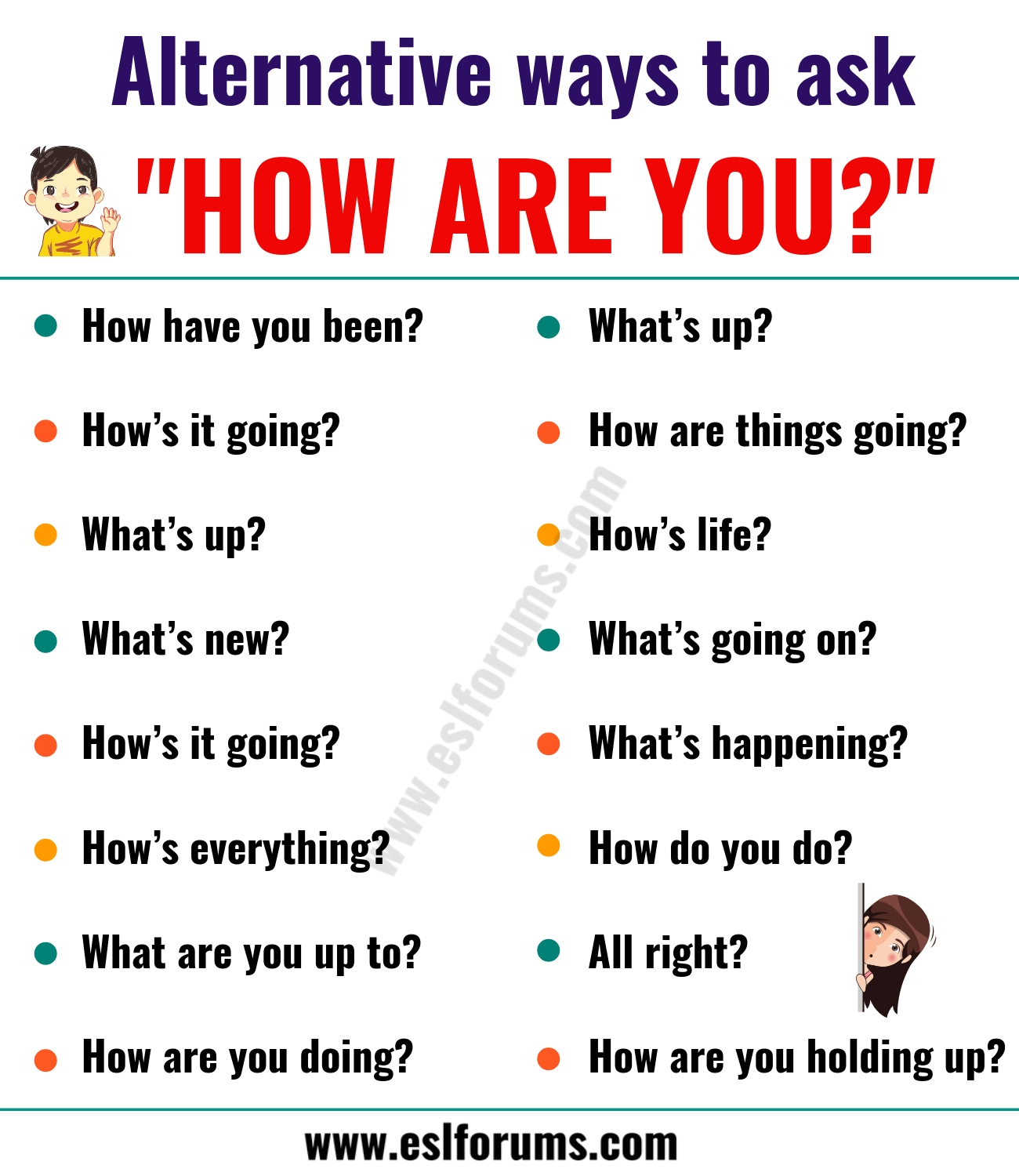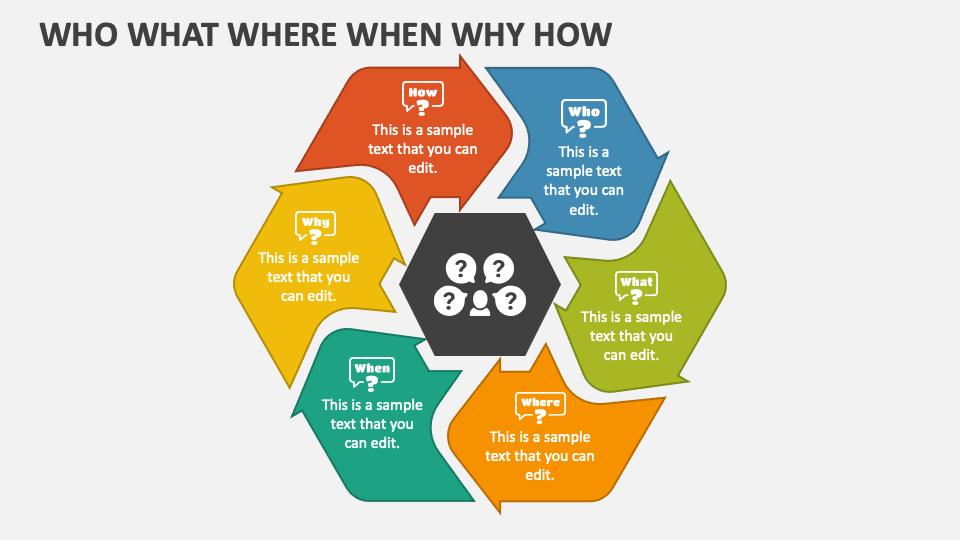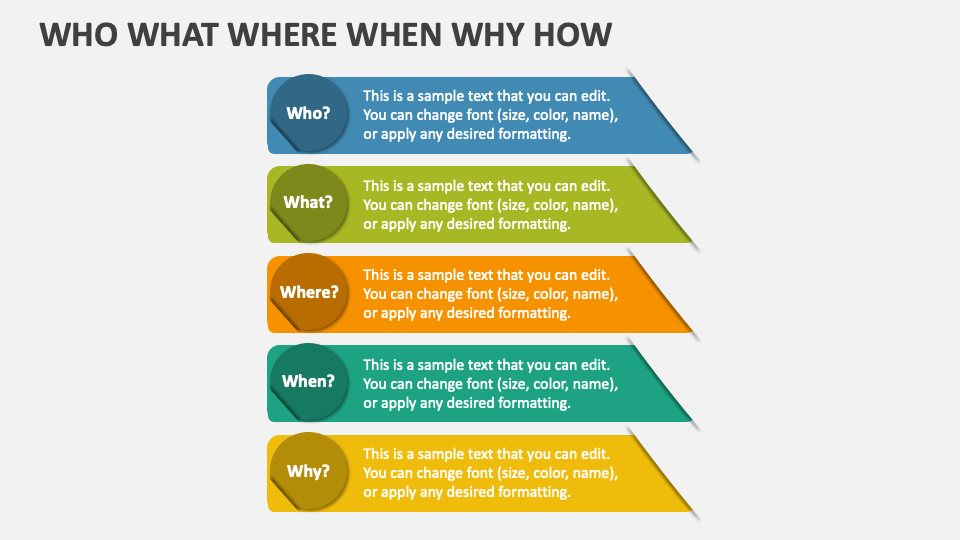Beyond "How Are You?": Mastering English Greetings
In the vast landscape of the English language, few phrases are as ubiquitous and fundamental as "How are you?". It's often one of the very first expressions learners encounter, serving as a cornerstone for initiating conversations. Yet, despite its simplicity and widespread use, many find themselves wondering if there are more engaging, nuanced, or simply different ways to pose this common question and, crucially, to respond to it authentically. This article delves deep into the art of asking and answering "How are you?", exploring its many facets and offering a rich tapestry of alternatives to elevate your English conversations.
From casual encounters with friends to more formal interactions, the way we greet others sets the tone for the entire exchange. While "How are you?" is perfectly acceptable, a deeper understanding of its variations and the appropriate responses can significantly enhance your fluency and confidence. We'll explore not just the creative alternatives but also the subtle social cues and grammatical underpinnings that make these interactions truly natural, helping you sound more like a native English speaker and fostering genuine connections.
Table of Contents
- The Ubiquity of "How Are You?"
- Why Seek Alternatives to "How Are You?"
- Creative Ways to Ask "How Are You?"
- Navigating Responses to "How Are You?"
- "How Are You?" as a Greeting vs. Inquiry
- The Grammatical Nuances: "Is," "Are," and Helping Verbs
- Mastering English Conversations: Beyond the Greeting
- Cultural Considerations in Greetings
The Ubiquity of "How Are You?"
"How are you?" is undeniably one of the most common greetings in the English language, serving as a verbal handshake that initiates countless daily interactions. It's often the very first phrase taught in English language classes, and for good reason: it's simple, versatile, and universally understood. Whether you're bumping into an acquaintance on the street, starting a meeting with a colleague, or reconnecting with a long-lost friend, this phrase feels natural and appropriate in a vast array of social contexts. Its simplicity belies its importance, acting as a social lubricant that eases the transition into deeper conversation.
- Pbr Mid American Classic 2024
- Johnny Rivers Wife
- Sierra Mccormick Legs
- Anna Malygon Onlyfan
- Crossway Church Sulphur Ok
The phrase's power lies in its dual function. On one hand, it's a perfunctory greeting, often requiring little more than a polite, brief response. On the other, it can genuinely inquire about someone's well-being, opening the door for a more detailed exchange about their day, health, or emotional state. This adaptability makes "How are you?" a cornerstone of English communication, a phrase that every learner must master not just in its asking, but in its varied responses.
Why Seek Alternatives to "How Are You?"
While "How are you?" is perfectly functional, relying solely on it can sometimes make your conversations feel repetitive or less natural. As the provided data suggests, many people find themselves bored with saying it, seeking more creative or interesting ways to greet others. The desire to add variety to your conversations and sound more natural is a key motivator for exploring alternatives. Native speakers rarely stick to just one greeting; they fluidly switch between phrases depending on the context, their relationship with the other person, and even their mood.
Using a broader range of greetings demonstrates a higher level of fluency and comfort with the language. It shows that you're not just reciting learned phrases but truly engaging with the nuances of English communication. Moreover, different greetings can subtly convey different levels of formality, intimacy, or curiosity. For instance, asking "What's new?" to a close friend implies a deeper interest in their life than a simple "How are you?" This desire for authenticity and conversational richness is what drives the exploration of diverse greeting options.
- Eli 1301 Spectrum
- Ghost Keyboards
- Maam That Is An Eleven Pound
- Noticias Univision 41 San Antonio Tx Hoy
- Cwb Chicago News
Creative Ways to Ask "How Are You?"
Moving beyond the standard "How are you?" opens up a world of conversational possibilities. The goal isn't to replace it entirely, but to have a repertoire of phrases that allow you to choose the most fitting one for any given situation. This not only makes your English sound more natural but also makes you feel more comfortable in English conversations, as highlighted by resources like "28 phrases to feel comfortable in English conversations."
Informal & Friendly Alternatives
When greeting friends, family, or close acquaintances, you can opt for more casual and warm alternatives. These phrases often feel less formal and more personal, signaling a relaxed relationship. Here are some popular choices:
- "How are you doing?": This is a very common and slightly more relaxed version of the original. It's widely used and sounds very natural.
- "How's it going?": Extremely common in informal settings, this is a versatile greeting that can be used with almost anyone you know well.
- "What's up?" / "What's new?": These are very casual and often used among younger people or close friends. They invite a brief update on what's been happening in the person's life.
- "How have you been?": Perfect for someone you haven't seen in a while. It implies a longer period and invites a summary of recent events.
- "Are you well?" / "Hope you're well.": A slightly more polite or concerned way to ask, often used in written communication or when genuinely inquiring about someone's health.
These phrases keep your greetings fresh and exciting, preventing the monotony that can come from always using the same expression. They allow you to tailor your greeting to the specific relationship and context, enhancing the natural flow of your conversation.
More Formal or Specific Inquiries
In professional settings, with strangers, or when you want to convey a particular nuance, more formal or specific alternatives are appropriate. These options maintain politeness while still offering variety:
- "How do you do?": While less common in everyday spoken English, this is a very formal greeting, often used upon first introduction. It's unique in that the expected response is often "How do you do?" in return, rather than an actual update on one's well-being. BBC Learning English often covers this specific nuance.
- "Are you doing well?": A polite and slightly more direct way to inquire about someone's general state, suitable for colleagues or in more formal interactions.
- "How's everything?" / "How are things?": These are broad inquiries that invite a general overview of the person's life or current situation, suitable for various contexts.
- "Is everything alright?" / "Are you alright?": These can carry a hint of concern, used when you suspect someone might be facing a challenge or not feeling their best.
Exploring these 26 creative ways to say "how are you?" with fun, unique alternatives truly helps to spark engaging conversations. It moves beyond rote memorization to genuine communicative intent.
Navigating Responses to "How Are You?"
Just as there are many ways to ask "How are you?", there are equally diverse ways to respond. The best response often depends on who's asking and the situation you're in. Whether you're talking to a friend, coworker, or stranger, your reply can range from a brief pleasantry to a more detailed account of your day. The key is understanding the social expectations and choosing a response that fits the context.
The Art of the Polite Reply
In many social contexts, especially with acquaintances or in passing, the question "How are you?" functions primarily as a greeting, not a genuine request for a detailed life update. In these scenarios, a short, positive, and polite response is usually expected. The data confirms this, noting that many responses are "not about expressing your real feelings or how you are actually doing that day, but rather are about giving a positive and polite response."
- "I'm fine, thank you.": This is the classic, universally understood, and safe response. It's polite and indicates general well-being without inviting further inquiry.
- "I'm doing well, thank you.": A slightly more enthusiastic and positive version of "I'm fine."
- "Not bad.": Just like "okay," the response "not bad" also has a neutral feel and is a common way to reply to "how are you?" It suggests things are generally acceptable, without being overly positive or negative.
- "Good, thanks." / "Great, thanks.": These are concise, positive, and widely used, especially in informal settings.
- "I'm feeling good." / "I'm feeling great.": These convey a more specific positive emotion and are excellent positive answers.
- "Can't complain.": A common, informal way to say things are going well enough.
Remember to reciprocate the question, often with "And you?" or "How about you?" This shows politeness and keeps the conversation flowing.
When to Share More Authentically
While brevity is often appreciated, there are times when a more honest and detailed reply is appropriate, even encouraged. This usually occurs with close friends, family members, or colleagues with whom you have a deeper relationship. In these instances, "How are you?" can genuinely inquire about your health or emotional well-being.
- "I've been better.": This is a subtle way to indicate that things aren't great without going into full detail. It opens the door for the other person to ask for more if they wish.
- "A bit tired, but otherwise good.": A common and honest response that provides a small detail without overwhelming the listener.
- "It's been a busy week, but I'm managing.": This gives context to your current state and can lead to a discussion about your activities.
- "To be honest, I'm feeling a bit stressed lately.": This level of honesty is reserved for truly close relationships where you feel comfortable sharing vulnerabilities.
The decision to give an honest reply or share more details about your day depends heavily on the context and your relationship with the person asking. It’s a nuanced social skill that develops with practice and observation.
"How Are You?" as a Greeting vs. Inquiry
One of the fascinating aspects of "How are you?" is its dual nature. It can be used purely as a greeting, much like "hello," or as a genuine way to inquire about the health or emotional well-being of someone. Understanding this distinction is crucial for both asking and answering appropriately.
When used as a greeting, particularly in passing or with someone you don't know well, the question is often rhetorical. The expectation is a quick, polite, and positive response, and then the conversation moves on, or both parties continue their separate ways. Think of a cashier asking you "How are you?" at the grocery store. They're not usually expecting a detailed account of your day's struggles; a simple "Good, thanks!" suffices.
However, when posed by a close friend, a family member, or someone who genuinely cares about your state, "How are you?" transforms into a sincere inquiry. In these cases, a more authentic and detailed response might be welcomed or even expected. For example, if you've been ill, a friend asking "How are you?" is likely looking for an update on your recovery. The context, the relationship, and even the intonation of the speaker all play a role in signaling whether it's a perfunctory greeting or a true inquiry. This adaptability is a testament to the phrase's utility in English communication.
The Grammatical Nuances: "Is," "Are," and Helping Verbs
While "How are you?" seems straightforward, it subtly introduces us to fundamental grammatical concepts in English, particularly the use of helping verbs and subject-verb agreement. The word "are" in "How are you?" is a form of the verb "to be," and it functions as a helping verb here, assisting the implied main verb (e.g., "doing" in "How are you doing?").
Helping verbs, also known as auxiliary verbs, are crucial components of English sentences. The most common helping verbs include "do," "does," "am," "is," and "are." They are found before the main verb in a sentence and help to express tense, mood, or voice. In the phrase "How are you?", "are" helps to form a question and indicates the present state of the subject "you."
Let's delve into the specific use of "are" and its relationship with subjects:
- "Are" with Plural Subjects: In English grammar, recognizing plural subjects is key to properly utilizing the verb form "are." "Are" is always used with plural forms. For instance:
- "They are happy."
- "The books are on the table."
- "My friends are coming over."
- "Are" with the Second Person Singular Pronoun "You": Uniquely, "are" is also used with the second person singular pronoun "you," even when "you" refers to a single person. This is a common point of confusion for learners, as other singular subjects take "is" (e.g., "He is," "She is," "It is").
- "How are you?" (even if addressing one person)
- "You are kind." (even if addressing one person)
- "Is" vs. "Are" with Compound Subjects: Compound subjects describe when a sentence has two or more subjects connected by "and" or "or." These subjects can be either singular or plural, so you have to check the usage before deciding between "is" and "are."
- When subjects are joined by "and," they usually form a plural subject, requiring "are": "John and Mary are here."
- When subjects are joined by "or" or "nor," the verb agrees with the subject closest to it: "Either John or Mary is coming." (Mary is singular) vs. "Either the dog or the cats are outside." (cats are plural).
Understanding these grammatical rules, while seemingly separate from conversational greetings, underpins the correct formation of questions like "How are you?" and countless other sentences. It highlights that even simple phrases are built upon a robust grammatical framework.
Mastering English Conversations: Beyond the Greeting
While mastering "How are you?" and its alternatives is a crucial first step, true conversational fluency extends far beyond greetings. As the provided data suggests, learning "28 phrases to feel comfortable in English conversations" points to a broader goal: to engage confidently and naturally in sustained dialogue. Once the initial greeting is exchanged, the conversation needs to flow, requiring skills in active listening, asking follow-up questions, expressing opinions, and sharing personal experiences.
To truly master English conversations, consider these aspects:
- Active Listening: Pay attention not just to the words, but the tone and context of the other person's response. This helps you formulate relevant follow-up questions.
- Follow-Up Questions: Instead of just giving a polite "I'm fine, thank you," and ending the exchange, ask "What about you?" or "What have you been up to?" to keep the ball rolling. If someone says "I've been busy," you might ask, "Oh, what kind of busy?"
- Expressing Empathy: If someone shares they've "been better," phrases like "I'm sorry to hear that" or "Is everything okay?" show genuine concern.
- Using Conversational Connectors: Phrases like "By the way," "Anyway," "Speaking of which," help transition smoothly between topics.
- Varying Your Vocabulary: Instead of always saying "good," try "fantastic," "terrific," "decent," or "so-so" to add nuance to your expressions.
The journey to conversational mastery is continuous, built on a foundation of basic greetings and expanding into a rich tapestry of expressions and interaction patterns. Resources like the BBC Learning English website, for example, frequently offer insights into natural English dialogue, reinforcing the importance of context and common usage.
Cultural Considerations in Greetings
The way to answer "How are you?" can also depend on where you are in the world. While English is a global language, cultural nuances can subtly influence greeting customs. What might be considered polite or normal in one English-speaking country could be slightly different in another.
For instance, in some parts of the United States, "How are you?" can be a very quick, almost rhetorical question, particularly in customer service interactions, where a simple "Good, thanks" is the expected and sufficient response. In contrast, in some parts of the UK, a more reserved or understated response might be common, or the question might genuinely invite a brief, honest update if the relationship is closer.
Consider also the concept of personal space and directness. Some cultures prefer more indirect communication, while others value straightforwardness. This can impact how much detail is shared in response to a greeting. While the core meaning of "How are you?" remains consistent, its social function and the depth of the expected reply can vary. Observing local customs and listening to how native speakers interact in specific regions can provide invaluable insights into these subtle cultural differences.
Conclusion
The humble phrase "How are you?" is far more than just a simple greeting; it's a gateway to connection, a reflection of social etiquette, and a practical lesson in English grammar. We've explored its pervasive presence, the compelling reasons to seek creative alternatives, and a diverse range of options for both asking and answering. From the informal "What's up?" to the polite "I'm doing well, thank you," understanding these variations empowers you to navigate English conversations with greater confidence and authenticity.
Remember that mastering greetings, like any aspect of language, is an ongoing process of observation and practice. Don't be afraid to experiment with new phrases, pay attention to the context, and always consider your relationship with the person you're speaking to. By diversifying your conversational toolkit and understanding the nuances of "how are you," you'll not only sound more like a native speaker but also foster more meaningful interactions. What's your favorite way to ask or answer "How are you?" Share your thoughts and experiences in the comments below, and explore our other articles for more tips on mastering everyday English conversations!

"How are you?" | 60+ Different Ways to Ask & Respond to "How are you

Who What Where When Why How PowerPoint Presentation Slides - PPT Template

Who What Where When Why How PowerPoint Presentation Slides - PPT Template